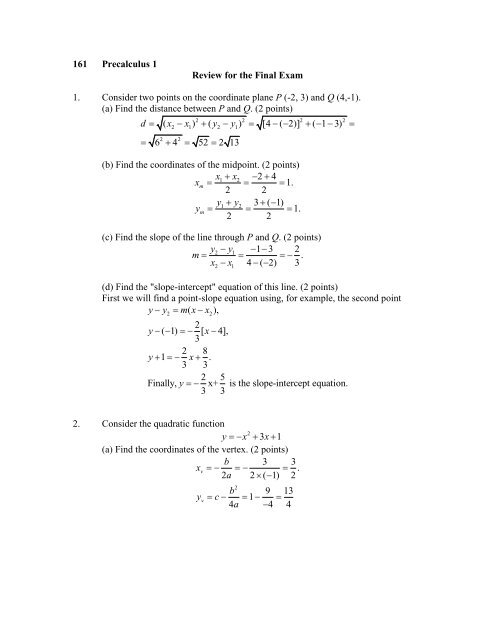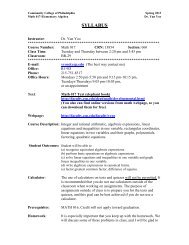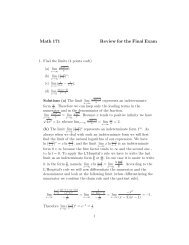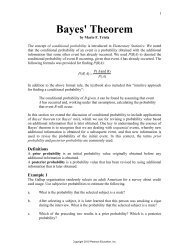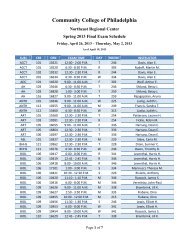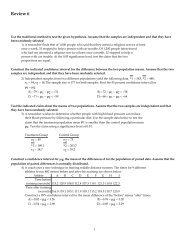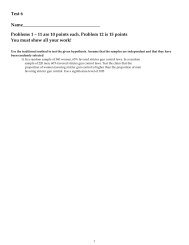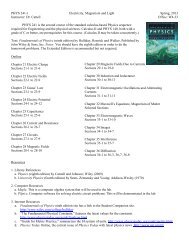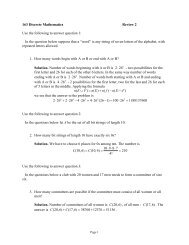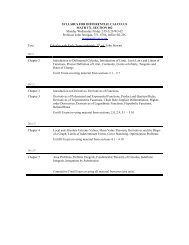161 Precalculus 1 Review for the Final Exam 1. Consider two points ...
161 Precalculus 1 Review for the Final Exam 1. Consider two points ...
161 Precalculus 1 Review for the Final Exam 1. Consider two points ...
Create successful ePaper yourself
Turn your PDF publications into a flip-book with our unique Google optimized e-Paper software.
<strong>161</strong> <strong>Precalculus</strong> 1<br />
<strong>Review</strong> <strong>for</strong> <strong>the</strong> <strong>Final</strong> <strong>Exam</strong><br />
<strong>1.</strong> <strong>Consider</strong> <strong>two</strong> <strong>points</strong> on <strong>the</strong> coordinate plane P (-2, 3) and Q (4,-1).<br />
(a) Find <strong>the</strong> distance between P and Q. (2 <strong>points</strong>)<br />
d ( x x ) ( y y ) [4 ( 2)] ( 1 3)<br />
2 2 2 2<br />
2 1 2 1<br />
2 2<br />
6 4 52 2 13<br />
(b) Find <strong>the</strong> coordinates of <strong>the</strong> midpoint. (2 <strong>points</strong>)<br />
x1 x2<br />
2 4<br />
xm<br />
<strong>1.</strong><br />
2 2<br />
y1 y2<br />
3 ( 1)<br />
ym<br />
<strong>1.</strong><br />
2 2<br />
(c) Find <strong>the</strong> slope of <strong>the</strong> line through P and Q. (2 <strong>points</strong>)<br />
y2 y1<br />
1 3 2<br />
m .<br />
x x 4 ( 2) 3<br />
2 1<br />
(d) Find <strong>the</strong> "slope-intercept" equation of this line. (2 <strong>points</strong>)<br />
First we will find a point-slope equation using, <strong>for</strong> example, <strong>the</strong> second point<br />
y y m( x x ),<br />
2 2<br />
y ( 1)<br />
2<br />
[ x<br />
3<br />
4],<br />
y 1<br />
2 8<br />
x .<br />
3 3<br />
<strong>Final</strong>ly, y<br />
2 5<br />
x+ is <strong>the</strong> slope-intercept equation.<br />
3 3<br />
2. <strong>Consider</strong> <strong>the</strong> quadratic function<br />
2<br />
y x 3x<br />
1<br />
(a) Find <strong>the</strong> coordinates of <strong>the</strong> vertex. (2 <strong>points</strong>)<br />
b 3 3<br />
xv<br />
.<br />
2a<br />
2 ( 1) 2<br />
y<br />
v<br />
2<br />
b 9 13<br />
c 1<br />
4a<br />
4 4
(b) Find <strong>the</strong> x-intercepts (if any). (2 <strong>points</strong>)<br />
x<br />
x<br />
1<br />
2<br />
b b 4ac<br />
3 13<br />
2<br />
2<br />
3 3 4 ( 1) 1<br />
2a<br />
2 ( 1)<br />
.3,<br />
3 13<br />
x2<br />
3.3.<br />
2<br />
(c) Find <strong>the</strong> range of <strong>the</strong> function. (2 <strong>points</strong>)<br />
The coefficient a is negative, <strong>the</strong>re<strong>for</strong>e <strong>the</strong> range is from <strong>the</strong> vertex down:<br />
(-∞, 13/4].<br />
(d) Graph <strong>the</strong> function. (4 <strong>points</strong>)<br />
.<br />
3. A rectangular plot of land on <strong>the</strong> edge of a river is to be enclosed with fence on<br />
three sides. Find <strong>the</strong> dimensions of <strong>the</strong> rectangular enclosure of <strong>the</strong> greatest area if<br />
<strong>the</strong> side that goes along <strong>the</strong> river does not require fencing and <strong>the</strong> total length of<br />
<strong>the</strong> fence is 200 m. (10 <strong>points</strong>)<br />
Let x be <strong>the</strong> side along <strong>the</strong> river and y be <strong>the</strong> perpendicular side. Then<br />
x 2y<br />
200.<br />
whence<br />
x 200 2 y .<br />
The area of <strong>the</strong> rectangle is<br />
2<br />
xy (200 2 y) y 2y 200 y .<br />
The greatest value of this quadratic function will be at <strong>the</strong> vertex
Then x 200 2 50 100.<br />
y<br />
200<br />
2 ( 2)<br />
50.<br />
4. Graph <strong>the</strong> polynomial function (10 <strong>points</strong>)<br />
2 2<br />
P( x) x ( x 4)<br />
The x-intercepts are at -2, 0, and 2. The function is positive to <strong>the</strong> left of -2 (because <strong>the</strong><br />
leading term is x 4 ). It changes sign at -2 and at 2 (because <strong>the</strong> exponent in each case is 1),<br />
but does not change sign at 0 (because <strong>the</strong> exponent is 2).<br />
5. Find <strong>the</strong> rational roots of <strong>the</strong> polynomial<br />
3 2<br />
x 6x 11x<br />
6<br />
and factor <strong>the</strong> polynomial completely. (10 <strong>points</strong>)<br />
Possible rational roots are factors of 6: 1,-1,2,-2,3,-3,6,-6. The solutions cannot be<br />
negative (every term becomes negative) so we try only 1,2,3,6. We can see at once that 1<br />
is a root and <strong>the</strong>re<strong>for</strong>e x-1 is a factor. From syn<strong>the</strong>tic (or long) division we see that<br />
3 2 2<br />
x 6x 11x 6 ( x 1)( x 5x 6) ( x 1)( x 2)( x 3) .<br />
The roots are 1, 2, 3.<br />
6. For <strong>the</strong> function<br />
f ( x) x 1 2<br />
(a) Find <strong>the</strong> domain. (3 <strong>points</strong>)
The function is defined when x 1 0, whence x <strong>1.</strong> The domain is <strong>the</strong> interval [1, )<br />
(b) Find <strong>the</strong> range. (3 <strong>points</strong>)<br />
All values from 2 and up. The range is <strong>the</strong> interval [2, ) .<br />
(c) Find <strong>the</strong> inverse function, its domain and range. (4 <strong>points</strong>)<br />
y x x y x y<br />
2<br />
1 2, 1 2, 1 ( 2) ,<br />
x y y y<br />
2 2<br />
( 2) 1 4 5.<br />
2<br />
The inverse g( x) x 4x<br />
5.<br />
The domain of <strong>the</strong> inverse function is <strong>the</strong> range of <strong>the</strong> original function’ in our case <strong>the</strong><br />
interval[2, ) .<br />
The range equals to <strong>the</strong> domain of <strong>the</strong> original function, [1, ) .<br />
7. For <strong>the</strong> rational function<br />
x 1<br />
f( x)<br />
2<br />
x 4<br />
(a) Find <strong>the</strong> horizontal or slant asymptote, if any. (3 <strong>points</strong>)<br />
2<br />
The ratio of leading terms is x / x 1/ x and it is close to 0 when x is a large positive or<br />
a large negative number. There<strong>for</strong>e <strong>the</strong> graph has <strong>the</strong> horizontal asymptote y=0 (<strong>the</strong> x-<br />
axis).<br />
(b) Find <strong>the</strong> vertical asymptotes, if any. (3 <strong>points</strong>)<br />
The denominator is 0 when x=2 or x=-2. The vertical asymptotes go through <strong>points</strong> 2 and<br />
-2 on <strong>the</strong> x-axis.<br />
(c) Find <strong>the</strong> x and y intercepts, if any. (3 <strong>points</strong>)<br />
The x-intercept: x=<strong>1.</strong> The y-intercept (when x=0) is ¼.
(d) Graph <strong>the</strong> function. (5 <strong>points</strong>)
8. For <strong>the</strong> functions<br />
f x x g x x<br />
(a) Find <strong>the</strong> compositions (4 <strong>points</strong>)<br />
f ( g( x)) and g( f ( x ))<br />
2<br />
( ) and ( ) 1<br />
2 2<br />
f ( g( x)) x 1, g( f ( x)) ( x) 1 x <strong>1.</strong><br />
(b) Find <strong>the</strong> domain of each composition function. (8 <strong>points</strong>)<br />
<strong>1.</strong> (-∞, ∞). 2. [0, ∞).<br />
9. Function f is defined in <strong>the</strong> following way<br />
f( x)<br />
0, x 0<br />
x, 0 x 1<br />
2 x,1 x 2<br />
0, x 2<br />
(a) Graph <strong>the</strong> function. (4 <strong>points</strong>)
(b) Graph <strong>the</strong> function g( x) 2 f ( x 1) 3. (4 <strong>points</strong>)<br />
(c) How are <strong>the</strong> <strong>two</strong> graphs related (2 <strong>points</strong>)<br />
We obtain <strong>the</strong> second graph if we move <strong>the</strong> first one by one unit to <strong>the</strong> left, stretch it<br />
twice along <strong>the</strong> y-axis, and move by three units down.<br />
10. <strong>Consider</strong> <strong>the</strong> following functions.<br />
f x x x<br />
4 2<br />
( ) 3 1,<br />
g x x x x<br />
5 3<br />
( ) 3 ,<br />
h( x)<br />
x x<br />
4 3<br />
(a) Which of <strong>the</strong>se functions are even (2 <strong>points</strong>)<br />
f ( x) f ( x), f is an even function.<br />
(b) Which are odd (2 <strong>points</strong>)<br />
g( x) g( x), g is an odd function.<br />
(c) What kind of symmetry do <strong>the</strong>ir graphs have (2 <strong>points</strong>)<br />
Graph of f is symmetric about <strong>the</strong> y-axis.<br />
Graph of g is symmetric about <strong>the</strong> origin.<br />
2 2<br />
1<strong>1.</strong> <strong>Consider</strong> <strong>the</strong> following equation of a conic. 8x y 2x 5y 0.<br />
a. Identify <strong>the</strong> conic (2 <strong>points</strong>). The conic is a hyperbola (or a degenerate conic) because<br />
<strong>the</strong> coefficients by x 2 and y 2 have opposite signs.<br />
b. Write an equation of <strong>the</strong> conic in <strong>the</strong> standard <strong>for</strong>m (5 <strong>points</strong>).
2 2 1 1 2 1 1 2 1<br />
8x 2x 8( x x) 8[( x ) ] 8( x ) ;<br />
4 8 64 8 8<br />
2 5 2 25<br />
y 5 y ( y ) .<br />
2 4<br />
After we plug <strong>the</strong>se expressions into original equation it becomes<br />
2 2<br />
( y 5/ 2) 8( x 1/8) 49 /8 , or<br />
2 2<br />
( y 5/ 2) ( x 1/8)<br />
<strong>1.</strong><br />
49/8 49/ 64<br />
c. Find <strong>the</strong> center, <strong>the</strong> vertices and <strong>the</strong> foci (5 <strong>points</strong>). The center is at (-1/8, -5/2). The<br />
axis of <strong>the</strong> hyperbola is vertical, a 7 /8, b 7 / 8 2.5 , and<br />
f<br />
49 49 21<br />
8 64 8<br />
vertices are at ( 1/ 8, 5 / 2 7 / 8) and ( 1/ 8, 5 / 2 7 / 8) . The foci are at<br />
(-1/8, - 41/8) and at (-1/8, 1/8).<br />
d. Graph <strong>the</strong> conic (5 <strong>points</strong>).<br />
. The


